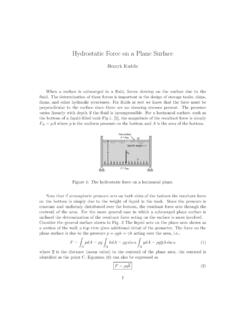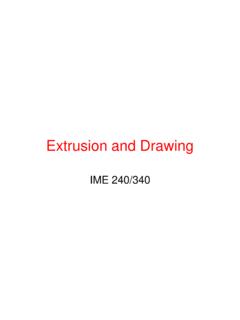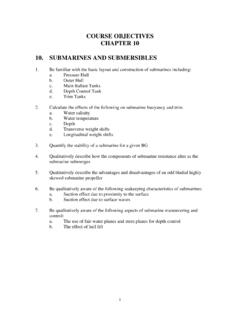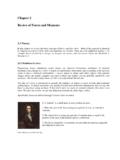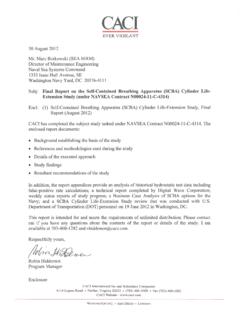Transcription of Hydrostatics Lab: Hydrostatic Pressure and Forces
1 P a g e | 1 Hydrostatics Lab: Hydrostatic Pressure and Forces John Felkins Abstract Hydrostatics offers physical explanations for many occurrences of everyday life, such as why atmospheric Pressure changes with altitude, why wood and oil float on water, and why the surface of water is always flat and horizontal whatever the shape of its container. In this lab, the center of Pressure and the force on a vertical rectangular surface partially, and then fully, submerged in water at rest were determined with an Edibon Hydrostatics Pressure System and set of weights with known masses. With the plate partially submerged, the centers of Pressure at separate (increasing) known weights were determined to be mm, mm, mm, mm, mm, mm, and mm with corresponding vertical Forces of N, N, N, N, N, N, and N respectively. Fully submerged, the centers of Pressure were determined to be mm, mm, mm, mm, mm, mm, mm, mm, mm, mm, and mm with calculated vertical Forces of N, N, N, N, N, N, N, N, N, N, and N respectively.
2 Keywords. Hydrostatics , Hydrostatic Pressure , Edibon Hydrostatics Pressure System, Center of Pressure , Vertical force , Rectangular surface, Partially submerged, Fully submerged. Introduction Hydrostatics is the study of fluid statics and is the basis to the study of hydraulics, fluid dynamics, which plays a huge role in engineering. Hydrostatic Pressure is the Pressure water exerts due to its weight per unit area at some depth. Some principles which always apply to Hydrostatic Pressure are that Pressure depends only on the depth of water above the point in question (not on the water surface area), Pressure increases in direct proportion to the depth of water, Pressure in a continuous volume of water is the same at all points that are at the same depth or elevation, and Pressure at any point in the water acts in all directions at the same magnitude. From these principles, it can be determined that a linear relation should exist between the Pressure and the force at some depth of a fluid at rest.
3 One area in which Hydrostatic Pressure is important to fields such as agriculture and biological systems engineering is in the measurement of bulk compressibility for agricultural products ( potatoes and apples) which relates to other properties of the products, such as the elastic properties of potatoes and the viscoelastic properties of fruits. Bulk compressibility of a material is the ratio of the change in volumetric strain to the change in Hydrostatic Pressure acting on the external surface of the material. Agricultural products vary widely; some are porous and tend to absorb fluid under Hydrostatic Pressure which can cause error in volume-change readings. It is important to understand and be able to calculate Hydrostatic Pressure in order to prevent this phenomenon P a g e | 2 from occurring when attempting to measure bulk compressibility (Chen et al., 1977). The tomato and other such fruits have an external skin and internal solid and liquid material assumed to be viscoelastic; the internal portion is free to exert Hydrostatic Pressure on the skin as stresses are applied externally.
4 Thus, it was concluded that a test providing stress from Hydrostatic Pressure would give a realistic evaluation of skin deformation and strength properties for such fruits (Allen et al., 1974). Hydrostatics is also the basis for the study of hydraulics, which are used every day in automobiles, farm equipment, construction equipment, lifting equipment. These are just some of the applications of Hydrostatics in the natural world. Objectives The objectives of this lab where for students to (1) become familiar with Hydrostatic Pressure system, (2) measure center of Pressure and force on a vertical rectangular surface when the surface is partially submerged, then fully submerged, in a liquid at rest, (3) plot required graphs, and (4) be able to calculate the center of Pressure and Hydrostatic force from obtained data of known mass of weights and height of fluid at rest. Methods and Materials The Edibon Hydrostatic Pressure System module used in this lab consists on a quadrant assembled on the arm of a scale that swings around an axis.
5 When the quadrant was introduced in the tank of water, the force that acted on the front rectangular surface exercised a moment with regard to the supporting axis. The swinging arm had a pan and an adjustable counter balance, the tank had adjustable supporting legs that determine its proper levelling, and it had a drainage valve. Figure 1 shows a photo of a Hydrostatic Pressure system and Figure 2 gives a diagram of the system. Figure 3 shows the submerged surface viewed from the left side of the tank in Figure 2. The depth of the centroid below the surface of the water is h. The x-y coordinate system has its origin at the centroid. The y-direction position of the center of Pressure , , is = + (1) Where is the moment of inertia of the surface about the x-axis, and A is the surface area. Buoyancy force is not neglected here. Buoyancy force is defined as the net Pressure force acting on a submerged body.
6 If we consider the Pressure force components acting in the horizontal and vertical directions, then the buoyancy force contributes to the moment about the device pivot. If instead we consider the Pressure Forces acting normal to the surface of the acrylic arc, then the buoyancy force does not appear because the normal Forces on the curved surface do not contribute a moment about the pivot of the device. This is due to the circular arc shape of the devices, because it allows us to measure the Hydrostatic Pressure Forces without accounting for the buoyancy effect. Consider the moment balance depicted in Figure 4. Only the force components normal to the surface are identified, no Forces are neglected because the Pressure force acts normal to the surface. In this particular apparatus it is easier to analyze the normal Forces directly than to separate the Forces into horizontal and vertical components. The local Pressure force on the curved surface of the acrylic is not zero.
7 However, the Pressure Forces on P a g e | 3 the curved surface do not contribute to moments about O because these Forces have lines of action that pass directly through O; thus, the device eliminates the contributions of all surface Forces except the force acting on the vertical surface . A moment balance about point O shows that the moment F (H + h) is balanced by WL. Figure 1: Hydrostatic Pressure System Figure 2: Hydrostatic Pressure System Diagram P a g e | 4 Figure 3: Rectangular Surface (with nomenclature for locating center of Pressure ) Figure 4: Hydrostatic Forces Normal to Curved Surface P a g e | 5 Figure 5: Given Lab Equations. Results and Discussions Figures 6A- 6E are the plots for when the rectangular vertical surface is only partially submerged and Figures 7A-7E are the plots of the data for when the rectangular vertical surface is fully submerged. Figure 6A: Counterweight Mass vs.
8 Theoretical (Estimated) Height Using Eqn. 1, the theoretical height of the fluid (water) is estimated for Figure 6A. This figure show the counterweight mass that corresponds to each certain theoretical height. These two sets of data show a power (non-linear) trend between the estimated height and its corresponding mass. As theoretical height increases, the change in counterweight mass changes exponentially. R = (kg)y (m)P a g e | 6 Figure 6B: Theoretical (Estimated) Height vs. Actual (Experimental) Height Figure 6B plots the estimated height versus the experimental height. This figure shows that there is a greater difference between the two data as each height increases. The greater the height of the water, the greater the difference between it and the corresponding theoretical height. Figure 6C: Center of Pressure vs. Height Figure 6C shows that when the apparatus is not fully submerged, there is a linear relation between the center of Pressure and the height.
9 This relation is that as the height of the water increases in height, the center of Pressure decreases in height. R = (m)h (m)R = . 0 10 . 0 20 . 0 30 . 0 40 . 0 50 . 0 60 . 0 70 . 0 80 . 0 90 . 1hp (m)h (m)P a g e | 7 Figure 6D: Hydrostatic force vs. Height Figure 6D plots the Hydrostatic force against the height of the water. It can be determined from this figure that as there is an increase in height there is also an exponentially related increase in the Hydrostatic force . Figure 6E: Standard Deviation vs. Height Figure 6E shows the standard deviation between the theoretical height and the actual height of the water plotted against the actual height. This figure shows that as the height is increased, its relation to the standard deviation slowly becomes more linear. R = (N)h (m) (mm)P a g e | 8 Figure 7A: Counterweight Mass vs. Theoretical (Estimated) Height Figure 7A shows that there is a linear relation between the theoretical height and the counterweight mass when the rectangular vertical surface is fully submerged unlike that of when the surface is only partially submerged.
10 Figure 7B: Theoretical (Estimated) Height vs. Experimental Height R = (kg)y (m)R = (m)h (m)P a g e | 9 Figure 7C: Center of Pressure vs. Height Figure 7D: Hydrostatic force vs. Height When fully submerged, as with the other plots for the fully submerged surface figures, the Hydrostatic force vs. height plot is linear. R = . 0 20 . 0 40 . 0 60 . 0 80 . 10 . 1 20 . 1 40 . 1 60 . 1 8hp (m)h (m)R = (N)h (m)P a g e | 10 Figure 7E: Standard Deviation vs. height The standard deviation vs. height plot for the fully submerged surface is not as smooth as that of the partially submerged surface and fluctuates more in a smaller set of heights. The figures for the two situations (partially and fully submerged) provide a common trend that when the vertical surface is only partially submerged there is a common exponential relation between data, and when the surface is fully submerged there is a common linear relation between the data.
